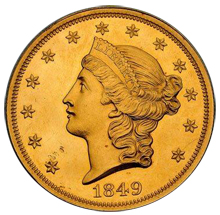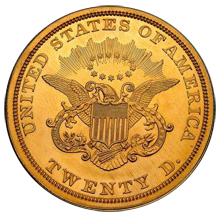 1849-C G$1 Open Wreath AU58 PCGS. It is with great pleasure that Heritage has been selected to auction this famous rarity, an issue that is by far the rarest coin struck in the Charlotte Mint. The 1849-C Open Wreath is truly the "King of Southern Gold Coins" and is without peer in this category. In terms of rarity, few major variety coins can boast a surviving known population of just 5 pieces. Of this tiny group, two examples have been sold in the past four years at auction; the finest is the recently reported NGC MS63 Prooflike example that was sold by David Lawrence Rare Coins in their Richmond I Auction in July of 2004 for $690,000. It was later sold by Heritage Rare Coin Galleries/Steve Contursi for a sum that is reportedly close to $1 million. This coin was apparently purchased privately over the counter some decades ago by a New York gold specialty firm and placed in a major collection where it remained quietly tucked away and unreported until widely publicized in the Richmond I Auction. The other recent appearance is an NGC Fine 15 coin that we sold in our 2003 FUN Auction for $97,750.
1849-C G$1 Open Wreath AU58 PCGS. It is with great pleasure that Heritage has been selected to auction this famous rarity, an issue that is by far the rarest coin struck in the Charlotte Mint. The 1849-C Open Wreath is truly the "King of Southern Gold Coins" and is without peer in this category. In terms of rarity, few major variety coins can boast a surviving known population of just 5 pieces. Of this tiny group, two examples have been sold in the past four years at auction; the finest is the recently reported NGC MS63 Prooflike example that was sold by David Lawrence Rare Coins in their Richmond I Auction in July of 2004 for $690,000. It was later sold by Heritage Rare Coin Galleries/Steve Contursi for a sum that is reportedly close to $1 million. This coin was apparently purchased privately over the counter some decades ago by a New York gold specialty firm and placed in a major collection where it remained quietly tucked away and unreported until widely publicized in the Richmond I Auction. The other recent appearance is an NGC Fine 15 coin that we sold in our 2003 FUN Auction for $97,750.
This particular coin displays the diagnostic weakness on the obverse star on the left side of the rim across from Liberty's nose. The obverse appears slightly concave, and the portrait has a medallic quality that gives a three-dimensional appearance to Liberty's head. The obverse dentils are slightly weak on the left, a common occurrence on early Charlotte Mint gold dollars. On the reverse the strike is not as sharp as that seen on the obverse, with some softness found on the 84 in the date, not unexpected as these digits are directly opposite Liberty's head. Importantly, the C mintmark is sharp, as are the leaves, legend, and denomination.
 Breen and Winter note several diagnostic features that are present on all known examples of this issue. The weak star opposite Liberty's nose has a short right point, the leaf below the 1 in the date is hollow, and the leafbelow the 9 shows a partially detached tip. (These last two features are likely caused by die polishing to prepare the dies for the initial coinage). The ribbons are also incomplete and there is a tiny die file mark above RI in AMERICA, again diagnostic features seen on all known examples. The color ranges from the usual bright yellow-gold with a dash of the greenish cast seen on most Charlotte gold of the period. Examination of the surfaces shows virtually no evidence of circulation and the trace of wear is limited to the highest design elements. The coin has a pleasing appearance and were this a more common gold dollar most collectors would find its charming color, luster, and surfaces perfectly suited to their tastes.
Breen and Winter note several diagnostic features that are present on all known examples of this issue. The weak star opposite Liberty's nose has a short right point, the leaf below the 1 in the date is hollow, and the leafbelow the 9 shows a partially detached tip. (These last two features are likely caused by die polishing to prepare the dies for the initial coinage). The ribbons are also incomplete and there is a tiny die file mark above RI in AMERICA, again diagnostic features seen on all known examples. The color ranges from the usual bright yellow-gold with a dash of the greenish cast seen on most Charlotte gold of the period. Examination of the surfaces shows virtually no evidence of circulation and the trace of wear is limited to the highest design elements. The coin has a pleasing appearance and were this a more common gold dollar most collectors would find its charming color, luster, and surfaces perfectly suited to their tastes.
How did the gold dollar come about? Originally proposed by Alexander Hamilton in 1791, the gold dollar was an integral part of his coinage scheme. However, the silver dollar ended up being the coin of choice for the initial American coinage starting in 1794. Because market conditions were always changing between the relative value of gold and silver, the silver dollar ceased coinage in 1803 (although a few more were reportedly coined until 1805, but these are believed to be dated 1803).
The discovery of gold in Rutherford County, North Carolina induced Christoph Bechtler to begin coinage of a gold dollar in 1831, as the remoteness of the North Carolina mines precluded safe shipment to Philadelphia of gold bullion for coinage. Recall that the Philadelphia Mint was the only operational Federal Mint at that time. Curiously too, is the fact that Bechtler's mine was one of the most productive and richest gold mines in America at that time. Bechtler did what any true American would do, he coined his own gold into dollars and other denominations which were widely accepted in that region. This competition did not go unnoticed by the Philadelphia Mint. By 1835, plans were hatched to open new federal branch mints in both Charlotte, North Carolina(Registry values: N1)